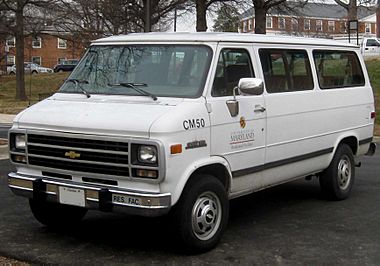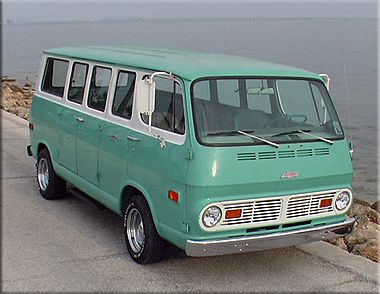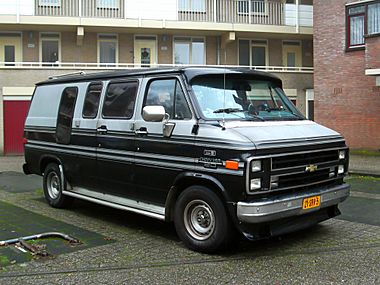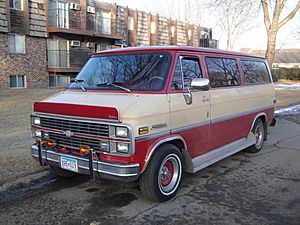Chevrolet van facts for kids
Quick facts for kids Chevrolet/GMC Van |
|
|---|---|
 |
|
| Overview | |
| Manufacturer | Chevrolet/GMC (General Motors) |
| Production | 1964–1996 |
| Assembly |
|
| Body and chassis | |
| Body style | Van |
| Chronology | |
| Predecessor | Chevrolet Greenbrier Sportswagon Chevrolet Suburban panel van |
| Successor | Chevrolet Express / GMC Savana |
The Chevrolet Van or Chevy Van was a popular range of vans made by General Motors from 1964 to 1996. It was also known as the Chevrolet/GMC G-series vans and GMC Vandura. These vans took over from earlier models like the Chevrolet Greenbrier and the panel van version of the Chevrolet Suburban. They were sold as vans for passengers, cargo vans, and even as special "cutaway" versions that could be turned into different custom vehicles.
Over its long history, the Chevy Van went through three main designs. The first two versions had the engine placed between the front seats, which was called a "forward control" design. The third generation moved the engine to the front, under a hood, like most cars today. These vans shared many parts with the Chevrolet C/K pickup trucks. After 1996, the G-Series vans were replaced by the Chevrolet Express and GMC Savana.
First Generation: 1964-1966
| First generation | |
|---|---|
 |
|
| Overview | |
| Manufacturer | Chevrolet |
| Also called | Chevrolet Sportvan GMC Handi-Van GMC Handi-Bus |
| Production | 1964–1966 |
| Assembly | Pontiac, Michigan, U.S. |
| Body and chassis | |
| Class | Compact van |
| Layout | FMR layout |
| Powertrain | |
| Engine | 153 cu in (2.5 L) I4 194 cu in (3.2 L) I6 230 cu in (3.8 L) I6 |
| Dimensions | |
| Wheelbase | 90 in (2,286 mm) |
The first Chevy Van was designed to compete with other popular compact vans of the time. It had a unique "cab-forward" design, meaning the driver sat right over the front wheels. The engine was placed in a special "doghouse" cover between and behind the front seats. This design helped maximize space inside the van for cargo.
These early vans used parts like engines and brakes from the Chevy II car. They were also sold by GMC as the "Handi-Van." The first-generation vans were only available with a shorter 90-inch wheelbase. They had a single, flat windshield.
When they first came out in 1964, these vans were mostly for carrying cargo. You could get windows as an option, but they were just cut into the sides. In 1965, Chevrolet introduced the "Sportvan," which had windows built right into the body. GMC called its window van the "Handi-Bus." These early vans didn't have features like air conditioning or power steering.
Key Changes Over the Years
- 1964: The first model was simple and box-shaped to carry lots of stuff. It came with a four-cylinder engine or an optional six-cylinder engine.
- 1965: Minor changes included wider grille openings for better cooling and the addition of seat belts. This year also saw the introduction of the more passenger-friendly Sportvan and Handi-Bus models.
- 1966: This was the last year for the flat windshield design. Backup lights were added, and emblems were moved to the front doors. New trim packages like the Sportvan Custom and Deluxe offered upgrades like chrome bumpers and two-tone paint.
Second Generation: 1967-1970
| Second generation | |
|---|---|
 |
|
| Overview | |
| Manufacturer | Chevrolet |
| Also called | Chevrolet Sportvan GMC Handi-Van GMC Handi-Bus |
| Production | 1967–1970 |
| Assembly | Pontiac, Michigan, U.S. |
| Body and chassis | |
| Class | Van |
| Layout | FMR layout |
| Powertrain | |
| Engine | 230 cu in (3.8 L) I6 250 cu in (4.1 L) I6 283 cu in (4.6 L) V8 307 cu in (5.0 L) V8 350 cu in (5.7 L) V8 |
| Dimensions | |
| Wheelbase | SWB: 90 in (2,286 mm) LWB: 108 in (2,743 mm) |
In 1967, the Chevrolet van got a big update. It kept the "forward control" design, but the engine cover ("doghouse") was made larger to fit an optional V8 engine. This also helped improve engine cooling. These vans were now available in two wheelbase lengths: the original 90-inch and a new, longer 108-inch version.
Updates and Features
- 1967: The van got a new look with headlights moved into the grille and a curved windshield. For the first time, a V8 engine was an option. A heavier-duty G-20 version was introduced for tougher jobs, with stronger suspension and increased hauling power.
- 1968: This year, side marker lights and reflectors became required by law, so the vans added them. The optional V8 engine was updated to a more powerful version.
- 1969: The Chevrolet "bowtie" emblem on the hood changed from red to blue. A new 3-speed automatic transmission became an option. "Body-integrated" air conditioning was offered, which was a ceiling-mounted unit in the back of the van.
- 1970: This was the last year for the square body style and drum brakes on the front. A larger inline-6 engine became standard. A more powerful 350 V8 engine might have been available as an option this year.
Third Generation: 1971-1996
| Third generation | |
|---|---|

1986 Chevrolet G20 conversion van
|
|
| Overview | |
| Manufacturer | Chevrolet |
| Also called | GMC Vandura |
| Production | April 1970 – June 1996 |
| Model years | 1971–1996 |
| Assembly | Lordstown, Ohio, United States (Lordstown Assembly) (1971-1992) Flint, Michigan, United States (Flint Truck Assembly) (1993-1996) Detroit, Michigan, United States (Chevrolet Detroit Truck & Bus Plant) (1993-1996 G30 HD/G3500 HD only) Scarborough, Ontario, Canada (Scarborough Van Assembly) (1974-1993) |
| Body and chassis | |
| Class | Full-size van |
| Body style | 3-door van 3+1 door wagon 4-door van |
| Layout | Front-engine, rear-wheel drive |
| Related | Chevrolet/GMC C/K |
| Powertrain | |
| Engine | 4.1L I6 4.3L V6 5.0L V8 5.7L V8 7.4L V8 6.2L diesel V8 (1982–93) 6.5L diesel V8 (1994–96) |
| Transmission | 3-speed automatic 4-speed automatic 3-speed manual 4-speed manual |
| Dimensions | |
| Wheelbase | 110 in (2,794 mm) (SWB) 125 in (3,175 mm) (LWB) 146 in (3,708 mm) (EWB) |
| Length | 178.2 in (4,526 mm) (SWB) 202.2 in (5,136 mm) (LWB) 223.2 in (5,669 mm) (EWB) |
| Width | 79.5 in (2,019 mm) |
| Height | 79.4 in (2,017 mm) (SWB) 79.2 in (2,012 mm) (LWB) 79.8 in (2,027 mm) (SWB) 81.9 in (2,080 mm) (LWB) |
In 1970, GM launched the third generation of G-series vans for the 1971 model year. This was a complete redesign. The biggest change was moving the engine to the front, under a proper hood. This made it easier to work on the engine from outside the van. These vans were built using a single body and frame (unibody construction) and shared many parts with the C/K pickup trucks.
This generation of G-series vans was produced for 25 years, making it one of the longest-running vehicle designs from General Motors.
Chassis and Engines
The third-generation vans came in three different lengths: 110 inches, 125 inches, and a super-long 146 inches. The front suspension was greatly improved, using coil springs for a smoother ride, similar to the C-series pickup trucks. The vans also switched from old-fashioned drum brakes to modern disc brakes on the front wheels. For safety, four-wheel anti-lock braking became standard in 1993.
Over the years, many different engines were offered.
- Early models (1971) had a 6-cylinder engine as standard, with V8 engines as options.
- In 1982, a 6.2-liter V8 diesel engine became an option for the first time.
- Later, a 4.3-liter V6 engine replaced the older 6-cylinder as the standard engine.
- Fuel injection was added to many engines in the late 1980s, making them more efficient.
- In 1988, a powerful 7.4-liter "big-block" V8 engine was introduced as an option.
- By 1990, manual transmissions were no longer offered, and automatic transmissions became standard.
Body Styles and Features
The G-series vans were sold by both Chevrolet and GMC. They came in different weight classes: half-ton, three-quarter-ton, and for the first time, a one-ton series. Both brands offered passenger and cargo vans.
- Cargo vans usually came with just a driver's seat, with an optional passenger seat.
- Passenger vans could seat anywhere from 5 to 15 people, depending on their length.
- From 1971 to 1977, the vans had different badges and grille designs for Chevrolet and GMC.
- In 1978, the outside look was updated with new grilles and larger bumpers. The dashboard was also redesigned and stayed mostly the same until 1996.
- In 1984, you could choose between a sliding side door or new swing-out side doors.
- For 1990, a super-long van was introduced, which could seat up to 15 passengers. This was a big step for the G-series.
- From 1992 to 1996, the vans received minor updates to their exterior. Safety features like a driver's side airbag were added in 1994.
- A special heavy-duty version called the G30 HD/G3500 HD was introduced in 1993. It was often used for recreational vehicles (RVs) and buses.
The last G-series van, sometimes called the "G-Classic," was made in June 1996, as its replacement was already being produced.
Different Models and Names
The G-series vans had different names depending on their payload (how much they could carry) and whether they were Chevrolet or GMC.
Chevrolet Vans
Chevrolet offered the Chevy Van for cargo and the Sportvan for passengers. There were also fancier passenger versions:
- Beauville: This was the top-of-the-line passenger van, offering upgraded seats and interior.
- Bonaventure: This model was a step up from the Sportvan but not as luxurious as the Beauville.
- Nomad: From 1977 to 1981, this version combined passenger comfort with a large cargo area.
- Caravan: This was a two-seat version designed for people who wanted to customize their vans.
Many Conversion vans were also made by other companies using the Chevy Van or GMC Vandura as a base. These were customized with fancy interiors, beds, and entertainment systems.
GMC Vans
GMC's versions were called the Vandura for cargo and the Rally for passengers.
- The Rally passenger van came in different trim levels, like the Rally Custom and Rally STX, similar to Chevrolet's Bonaventure and Beauville.
- GMC also had the Gaucho (like the Nomad) and the Gypsy (like the Caravan) for customization.
- Special "cutaway" versions of the Vandura were used to build things like ambulances or small buses.
Concept Vehicles
In 1966, General Motors created a special concept vehicle called the Electrovan, based on the GMC Handi-Van. This van was powered by a special type of fuel cell that used hydrogen and oxygen to create electricity for its motor. It was an early look at electric vehicles, but it was too expensive and had safety concerns, so it never went into production.
See also
 In Spanish: Chevrolet Van para niños
In Spanish: Chevrolet Van para niños



